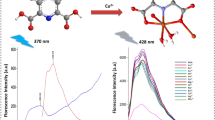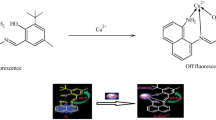Summary
Tetrasodium salts of copper(II) 4,4′,4″,4‴-tetrasulphophthalo-cyanine 2-hydrate, nickel (II)4,4′,4″,4‴-tetrasulphophthalocyanine, nickel(II) 3,3′,3″,3‴-tetrasurphophthaloycanine and cobalt(II) 4,4′,4″, 4‴-tetrasulphophthalocyanine 2-hydrate, and copper phthalocyanine trisulphonic acid are prepared in pure state. The molar absorptivity and formal redox potentials of the complexes are determined. The complexes are proposed as sensitive redox indicators in the micro determination of iron(II), arsenic(III), molybdenum(V), uranium(IV) and hydroquinone with 0.001–0.0005N cerium(IV) sulphate in sulphuric, hydrochloric and acetic acid media. They give sharp colour change from light turquoise blue to pale purple colour at the equivalence point. They have advantages over a few existing redox indicators.
Zusammenfassung
Die Tetra-Natriumsalze von Kupfer(II)-4,4′,4″,4‴-tetrasulfophthalo-cyanin-2-hydrat, Nickel(II)-4,4′,4″,4‴-tetrasulfophthalocyanin, Nickel(II)-3,3′,3″,3‴-tetrasulfophthalocyanin, Kobalt(II)-4,4′,4″,4‴-tetrasulfophthalo-cyanin-2-hydrat und Kupfer-phthalocyanin-trisulfonsäure wurden in reinem Zustand hergestellt. Die molare Extinktion und die formalen Redoxpotentiale dieser Komplexverbindungen wurden bestimmt. Die Komplexe wurden als empfindliche Redoxindikatoren für die Mikrobestimmung von Fe(II), As(III), Mo(V), U(IV) und Hydrochinon mit 0,001–0,0005N Cer(IV)sulfat in schwefelsaurer, salzsaurer und essigsaurer Lösung vorgeschlagen. Sie geben scharfe Farbumschläge von Hell-türkisch-blau nach Blaß-purpur beim Äquivalenzpunkt. Gegenüber bekannten Redoxindikatoren bieten sie Vorteile.
Similar content being viewed by others
References
G. F. Smith and J. S. Fritz, Analyt. Chemistry20, 874 (1948).
Lee Kum-Tatt and H. K. Tong, Analyt. Chim. Acta26, 583 (1962).
H. Sanke Gowda and B. Narayana Achar, Proc. Nat. Acad. Sci. India43 (A), 125 (1973).
J. H. Weber and D. H. Busch, Inorg. Chem.4, 469 (1965).
DPA F 1251, Farbenfabriken, Bayer AG, West Germany.
A. A. Spryskov and A. I. Kobenin, Trudy Ivon, Khim. Tekh. Inst.5, 196 (1956).
I. M. Kolthoff and R. Belcher, Volumetric Analysis III, New York: Interscience. 1957. p. 41.
G. F. Smith and Wm. M. Banick, Jr., Talanta2, 348 (1959).
P. George, D. J. E. Ingram, and J. E. Bennett, J. Amer. Chem. Soc.79, 1870 (1957).
E. Bishop and A. B. Crawford, J. Royal Tech. Coll. Glasgow5, 52 (1950).
A. A. Schilt, Analyt. Chemistry35, 1599 (1963).
Author information
Authors and Affiliations
Rights and permissions
About this article
Cite this article
Gowda, H.S., Achar, B.N. Sulphonated metal phthalocyanine complexes as redox indicators in micro titrations with cerium(IV) sulphate. Mikrochim Acta 74, 301–307 (1980). https://doi.org/10.1007/BF01196455
Received:
Issue Date:
DOI: https://doi.org/10.1007/BF01196455




